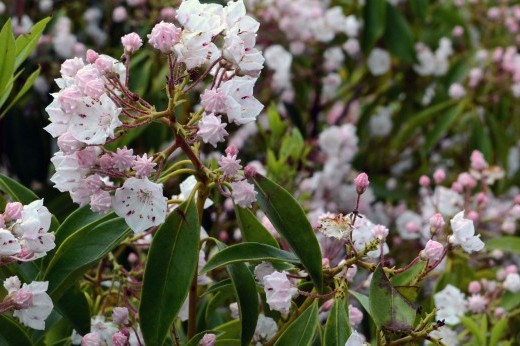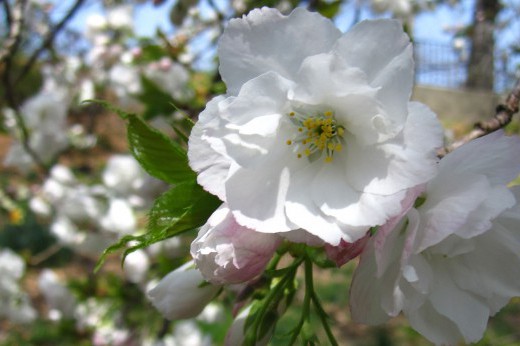If I asked you to name some small flowering trees for the garden, chances are Prunus mume, the Japanese flowering apricot, would not top your list. This tree remains surprisingly little known in the United States despite the fact that it has long been a favorite in Japan, where there are an estimated 300 named cultivars. If it were not for the tireless efforts of Dr. J. C. Raulston of the North Carolina State University Arboretum, who has made Prunus mume something of a personal crusade, this tree would be even less known here than it is today. Almost every reference to it in our popular gardening literature identifies Dr. Raulston himself or his students. Even Michael A. Dirr in his Manual of Woody Landscape Plants credits Dr. Raulston with bringing Prunus mume to his attention; it was added to the Manual, considered by many to be the gardener's bible, only in the 1990 revised edition.
The relative inattention paid this remarkable tree by the gardening world becomes difficult to understand when you look at the tree itself. At 20 feet it is an ideal size for small gardens or a fine accent for larger landscapes. In late spring and summer, handsome dark green foliage, dramatically colored, dark green stems and a pleasant rounded habit distinguish Prunus mume. But it is during the dark days of winter that this plant exhibits its unique charm. Starting as early as January, depending on the cultivar, the site and the weather, Prunus mume produces beautiful, delicate, fragrant flowers over many weeks just when we need them most. The flowers can be white to red through pink, single or double, and have a rich and spicy fragrance.
More: Mountain Laurel - A Shade-Tolerant Plant With Beautiful Blossoms
Native to China and Korea, where it has been cultivated for 1500 years, and long known in Japan where it is highly valued as an ornamental, Prunus mume was introduced to Britain in the mid-nineteenth century when some double-flowering Japanese cultivars were imported. However, it wasn't until the end of the century that it became established in cultivation. Even today, the eighth edition of W.J. Bean's Trees and Shrubs Hardy in the British Isles, after describing the tree's virtues, notes that it is uncommon and listed only by a few nurserymen.
Not So Fussy
Prunus mume is a sturdy tree resistant to most insect pests and diseases and hardy to USDA zone 6; it is unlikely that it can survive winters in climates north of New York City. Although not particularly fussy about soil, it will not tolerate a heavy or wet soil. For maximum effect, plant trees along a frequently used walkway or close to your house; remember that its blooming time is the middle of winter when cold weather restricts outdoor activities.
Sheltering, particularly in zone 6, is recommended. The disadvantage of this is that it may encourage the flowers to open too early leaving them vulnerable to frosts. Dr. Raulston suggests planting two trees, one in the most sheltered spot and another in the most exposed, covering your bets so to speak, to ensure good flowering. This is probably not practical for most gardeners who must choose between the lure of the early bloom with the attendant risk of losing some flowers and the later more consistent flowering.
Flowering varies, depending on the severity of each winter's weather. The flower buds of Prunus mume have a staggered dormancy so that, should a cold spell kill all the open flowers and swollen buds, as almost inevitably happens in our climate, there will still be more unharmed dormant buds. The staggered dormancy ensures a long period of flowering. However, because many of the blossoms are prone to winter damage, the possibility of setting fruit is drastically reduced. When fruit is set, it is ornamental-about an inch in diameter and yellow. Although in the West it is generally considered inedible, in the East the bitter and sour fruit is reportedly eaten salted, dried as a vegetable or soaked in alcohol for several years.
Winter Blossoms
Prunus mume blooms on the previous year's wood, the buds being set during the growing season of the year before, so be careful when pruning not to remove all the flower buds. Prunus mume should be pruned after flowering; cut half of the long shoots back by one-half to two-thirds so that each year you will have both encouraged long shoots on which more flowers will be produced in the future and still saved enough flower buds for the coming winter. Prunus mume will benefit in flower production and in overall vigor from this kind of regular pruning. Although the tree is considered to be short lived in the United States, specimens at BBG are over ten years old, and twenty years is not an unusual age for the trees to reach. Replacing them seems a small price to pay for such beauty.
Although a rare tree in the trade, Prunus mume is by no means impossible to find. Several good cultivars are available. W.B. Clarke, an American hybridizer, named three of the most readily available to American gardeners. 'Peggy Clarke' is a double-flowering cultivar with rose-pink petals crowned with a bright red calyx. 'Rosemary Clarke', a particularly early double-flowered bloomer, is white with a red calyx, and 'W.B. Clarke' is a graceful weeping form with double pink flowers.
Particularly unusual and hard-to-find is the contorted form, Prunus mume 'Contorta'. Although there are many Japanese varieties in cultivation, in this country 'Kobai', with deep red semidouble flowers, is probably the least difficult to find. The species itself, with single flowers and a color range from white to pink, is the most readily available in American nurseries.
Propagation
Prunus mume species may be propagated from seed extracted from ripened fruit. Stratify in plastic bags filled with a moist mixture of one-half milled sphagnum moss and sand for three months in the refrigerator, and then sow outdoors in spring or in the greenhouse any time of year.
For cultivars true to form, you'll have to propagate from softwood cuttings taken in early summer and kept misted. Prunus mume can also be grafted by T or chip buddings with buds from soft or semi-hard wood onto the more available purple leaf plum, Prunus cerasifera, understock.
Prunus mume will flower in three years from seed and in two from grafts. The tree grows quickly when young, three to seven feet per year, except for the contorted varieties which are slower growing.
Where to See It
At BBG the rose-pink-flowered American cultivar 'Peggy Clarke' and the Japanese cultivar 'Kobai' with deep red flowers both grow in front of the Administration Building along Washington Avenue. Another Japanese cultivar, the blush pink-flowered 'Kasugano', can be found across from the Japanese garden. Prunus mume has long been a favorite with Japanese bonsai masters; an unusual 23-year-old specimen can be seen in the Garden's bonsai collection.
Perhaps the largest collection of Prunus mume is found in Raleigh, North Carolina, at the North Carolina State University Arboretum, where some 50 varieties are grown.
Sources:
Camellia Forest125 Carolina Forest Road
Chapel Hill, NC 27516
919-967-5529 Woodlanders, Inc.
1128 Colleton Ave.
Aiken, SC 29801
803-648-7522 Greer Gardens
1280 Good Pasture Island Rd.
Eugene, OR 97401-1794



